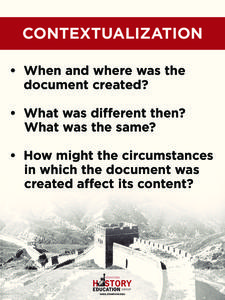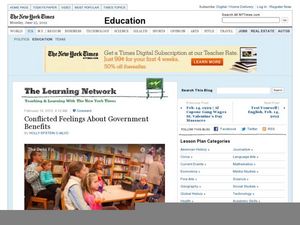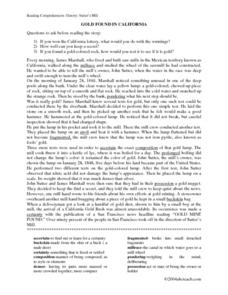Stanford University
Close Reading
Here's a poster that highlights the skills needed for the close reading of primary source documents when gathering evidence to support historical claims.
Mr. Nussbaum
Abraham Lincoln Reading Comprehension—The Presidential Years (Part 4)
How do you bring a nation back together after there is civil war? Readers learn how the United States Civil War concluded with a passage focused on the latter part of Abraham Lincoln's presidency. Multiple choice questions check pupils'...
iCivics
Step 3: Become an Expert
Have you ever been called an expert before? Pupils analyze how to break down sources of information using group work and individual skills. They begin to understand the tools of becoming an expert on a topic by using subtopics and...
Curated OER
Free Enterprise -- Product Cost
High schoolers are introduced to the concept of free enterprise. In groups, they discuss the price of various food items and decide on which item to produce. They calculate the cost of producing the item and share their results with...
Curated OER
'Free' Credit Reports Sometimes Aren't Free
Students explore the concept of credit. In this credit lesson, students read an article about 'free' credit reports. Students research the three on-line credit bureaus. Students discuss ways to obtain good credit and ways to stay away...
iCivics
Step Five: All about Public Policy
Public policy is important to understand because it affects everyone. The resource tells middle schoolers how the government uses policy to accomplish goals in the administration. It includes a reading, true or false worksheet, a...
iCivics
A Very Big Branch
Through detailed secondary source reading material and an interactive "true/false" activity, learners discover the depth and complexity of the executive branch in the United States government. Topics covered include executive...
Curated OER
Christopher Columbus
In this Christopher Columbus worksheet, 3rd graders will read a six paragraph passage. Students will then answer seven multiple choice questions about what they have read.
Curated OER
Little House in the Big Woods
Strengthen your learners' relationship with Laura Ingalls Wilder's classic novel of a pioneer family with these materials. Multiple choice comprehension questions and a set of reflection prompts are provided for each pair of chapters in...
Stanford University
Contextualization
Part of a series of posters designed to be used with a unit fostering the skills needed to read like a historian, this template models the questions researchers need to ask to contextualize a primary source document.
Curated OER
Cartoons for the Classroom: Fair Elections?
Rigged elections make for both intriguing current events and hilarious political cartoons. In this analysis worksheet, pupils read background information to help them grasp a cartoon about rigged presidential elections in 2007 by Russia,...
Curated OER
Conflicted Feelings About Government Benefits
Government spending on social programs in the US is a big topic. It is also the current event kids will read about as they delve into this issue of the New York Times. They'll read the article, then answer seven comprehension questions....
Ashbrook Center at Ashland University
Bill of Rights
Do citizens need protection from the federal government? Scholars investigate why the framers of the Constitution created the first 10 amendments and what these amendments mean to citizens of the United States more than 200 years later....
Curated OER
Holocaust Heroes
Students examine the contributions of Holocaust heroes. In this Holocaust lesson, students watch "Holocaust Heroes," and discuss the stories shared in the video. Students create scrapbooks that feature the real or fictional account...
Curated OER
Science in History Part I: the Abacus To the Modern Computer
In this math information worksheet, students read one page factual accounts of the early math inventions of the abacus, the calculator and early computers. There are 40 questions to answer about the reading.
abcteach
Gold Found in California
In this historical reading comprehension learning exercise, students read a factual account of the Gold Rush. Students answer 14 questions about the passage.
New York City Department of Education
Egypt
This six-week unit encompasses all subjects with a focus study on world history and the development of ancient civilizations. As gifted and talented students dive into the interesting yet challenging topic of Egypt, they...
Curated OER
Dialogues Concerning Natural Religion
Spark Notes proves a useful tool in this online interactive quiz, designed for scholars reading David Hume's Dialogues Concerning Natural Religion. After responding to 21 multiple-choice reading comprehension questions, scholars get...
Curated OER
Imperialism in China
If you are completing a unit on the European impact on China, this short lesson may be useful. It requires an excerpt from Chinese Civilization: A sourcebook, by Ebrey, that gives Liang Qichaos's account of his visit to America....
Curated OER
Looking Back
Students examine the difference between a communist and a free-market economy. They discuss challenges occurring in Macedonia and explain the mood of its people.
BrainPOP
U.S. Symbols
United States symbols are the subject of a video brought to you by BrainPop Jr. Hosts, Annie and Moby, begin with a definition of the word symbol, then go on to detail ten American symbols—the American flag, a Bald Eagle, the Liberty...
Historical Thinking Matters
Social Security: 5 Day Lesson
Did the New Deal fundamentally shift the role of the American government in the economy? Your class members will examine the interpretations of various historians in answering this question, and use a variety of primary and secondary...
Facing History and Ourselves
What Does It Mean to Belong?
After reading and analyzing The 'In' Group by Eve Shalen, sixth graders consider how the categorization of people results in exclusion, discrimination, and injustice.
Facing History and Ourselves
How Do Others Define Your Identity?
Sixth graders examine the relationship between the individual and society. In this World History lesson, learners read a book that discusses labels put on individuals. Students create a story board in relation to...























